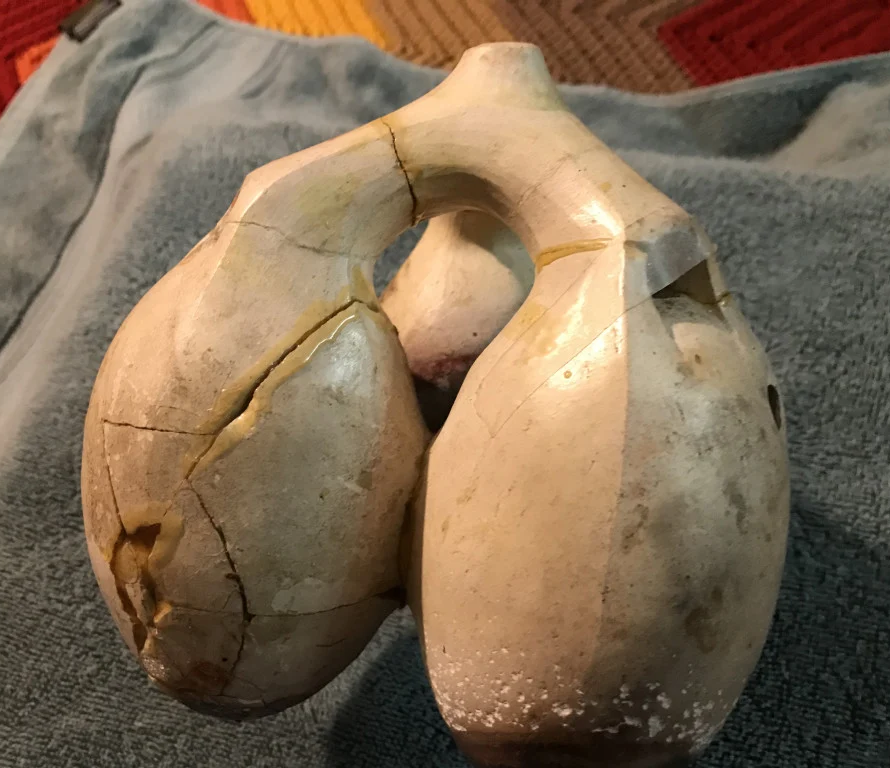Huaca
Vessel Flutes
America
Between 0 and 1000 AD
Video
The huaca is a unique wind instrument from South America, specifically associated with ancient Andean cultures. It is a type of aerophone that produces sound when air is blown into its hollow chambers. The huaca is typically made from ceramic or clay, featuring multiple chambers that allow it to produce a range of pitches and harmonics. This instrument has a distinctive shape, often resembling animal figures, human heads, or abstract geometric designs, showcasing the artistic ingenuity of the Andean civilizations. While the huaca is lesser known than other indigenous wind instruments like the pan flute or quena, it plays an important role in the musical traditions of pre-Columbian cultures.
It belongs to the aerophone family, which includes instruments that produce sound through the vibration of air. It is a type of whistle or flute with multiple chambers, making it distinct from single-chambered flutes. Because of its construction, it is classified as a multi-chambered duct flute. This design enables it to produce unique harmonic effects and multiphonic sounds, which were likely used for ceremonial or ritualistic purposes. Some variations of the huaca function as vessel flutes, where the shape of the chamber influences the tonal quality and resonance.
History
The huaca originates from the Andean region of South America, with historical evidence pointing to its use by ancient civilizations such as the Moche, Nazca, and Inca. It dates back to at least the first millennium CE, with some artifacts suggesting an even earlier existence. Archaeological findings show that the huaca was commonly used in present-day Peru, Ecuador, and Bolivia. These instruments were often discovered in burial sites, indicating their spiritual and ceremonial significance. The term “huaca” itself, in the Quechua language, refers to a sacred object or place, reinforcing the notion that these instruments held a profound cultural and religious role. Over time, the use of the huaca diminished with the Spanish conquest and the introduction of European musical traditions. However, modern reconstructions and revivals have brought renewed interest in this ancient instrument.
Materials Used in Construction
Traditional huacas were primarily made from clay or ceramic, materials that were readily available and easily molded into intricate shapes. Some variations incorporated other materials such as wood, bone, or stone, but ceramic remained the most common due to its ability to be sculpted and fired for durability. The decoration of huacas often featured elaborate carvings or painted motifs depicting animals, deities, or mythological themes, reflecting the artistic expression and spiritual beliefs of their creators. The use of natural pigments for coloring and surface embellishments further added to their aesthetic and symbolic value.
Types of Huacas
Huacas come in various forms, distinguished by their structure, number of chambers, and tonal capabilities. Some common types include:
Single-Chambered Huacas – These function similarly to traditional whistles and produce a single pitch.
Multi-Chambered Huacas – Featuring multiple resonating cavities, these huacas allow for harmonic and polyphonic sound production.
Figurative Huacas – Designed in the shape of animals, humans, or sacred symbols, often serving ritualistic or decorative purposes.
Vessel Flutes – Huacas shaped like containers or bottles, where the internal air volume contributes to the tonal quality and resonance.
Each type of huaca served different functions, from simple musical entertainment to sacred ceremonial use.
Characteristics of the Huaca
The huaca is characterized by its distinct timbre and the ability to produce multiple tones simultaneously due to its multi-chambered design. Its pitch range varies depending on the number of chambers and the size of the instrument. Most huacas produce warm, breathy sounds that can be modulated by controlling airflow and finger placement. The instrument’s design often includes intricate carvings and symbolic artwork, making it not only a musical tool but also a piece of cultural and artistic significance. The huaca’s construction also allows for a variety of playing techniques, enabling musicians to create unique soundscapes.
Design and Sound Profile
The typical Huaca has three or four chambers tuned to specific keys and scales. The front chambers are usually medium or high-pitched and are played with the fingers, while a lower-pitched chamber is controlled by the thumbs or even palms and forearms2. The tunings can range from chromatic to pentatonic scales for the higher pitched chambers.One of the notable features of some custom-made Huacas is their ability to play different musical scales across all three chambers. This allows for complex harmonies not easily achievable with traditional instruments1.
Artistic Use
Alan Tower is one prominent composer associated with the Huaca. He has released music featuring this instrument through his non-profit organization Octave Alliance, which focuses on nature/world music related to social change1. His work includes sounds from natural environments like ocean depths.
Playing Methods
Playing the huaca requires controlled breath techniques and finger dexterity. The musician blows air into the instrument’s mouthpiece while adjusting finger placement on the chamber openings to alter the pitch. The multi-chambered design allows for the combination of notes, enabling polyphonic effects. Some musicians use circular breathing techniques to sustain long notes, while others experiment with dynamic air pressure to produce varied tonal expressions. The huaca’s design also encourages improvisation, making it a versatile instrument for both traditional and contemporary musical contexts.
Roles in Music
The huaca played a crucial role in the musical traditions of pre-Columbian civilizations. It was primarily used in religious ceremonies, healing rituals, and social gatherings. The instrument’s unique sound was believed to have spiritual properties, capable of invoking deities or communicating with the supernatural. Some huacas were specifically designed for shamanic practices, where they were used to induce trance-like states. Additionally, huacas were incorporated into processional music, often played alongside drums, rattles, and other wind instruments to create immersive soundscapes. In contemporary times, the huaca has been revived in experimental music and world music ensembles, showcasing its adaptability beyond its traditional context.
Cultural Significance
The huaca holds deep cultural and spiritual significance within Andean traditions. The word “huaca” itself refers to something sacred, and these instruments were often regarded as more than just musical tools—they were conduits for divine communication. Many huacas were found in burial sites, suggesting their role in funeral rites and the belief in music as a bridge between the physical and spiritual worlds. The imagery depicted on huacas often related to cosmology, mythology, and ancestral veneration, reinforcing their importance in religious practices. The instrument’s resurgence in modern times highlights its enduring legacy and the continued appreciation for indigenous Andean musical heritage. Today, musicians and historians strive to preserve the huaca’s rich history and unique sonic qualities through research, reconstruction, and performance.
The huaca, though once an ancient relic, remains a testament to the ingenuity and artistic expression of pre-Columbian societies. Its revival not only enriches the understanding of Andean musical traditions but also inspires new generations to explore the depth of indigenous musical heritage. Whether played in traditional ceremonies or experimental compositions, the huaca continues to captivate listeners with its haunting, otherworldly sounds, ensuring its place in the ever-evolving world of music.
FAQ
What is the Huaca musical instrument?
The Huaca is a pre-Columbian ceramic wind instrument from South America, particularly used by Andean cultures. It consists of multiple connected chambers producing varied tones. Traditionally, it was used in rituals and ceremonies. Modern versions are often crafted for contemporary music.
How does the Huaca produce sound?
The Huaca produces sound when air is blown into its chambers, creating different pitches depending on the size and shape. Each chamber acts as an individual resonator, allowing polyphonic melodies. Players use breath control and finger holes to modify tones. This makes it unique among wind instruments.
What materials are used to make a Huaca?
Traditional Huacas are made from clay or ceramic, often hand-shaped and kiln-fired. Some modern versions use synthetic materials for durability. The construction method affects the instrument’s tone quality. Decorative carvings and paintings are also common in traditional designs.
 Links
Links
References
Other Instrument
Categories



















